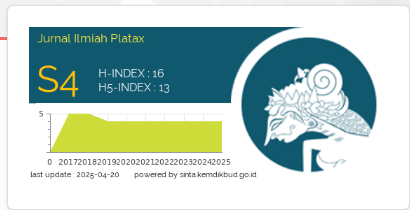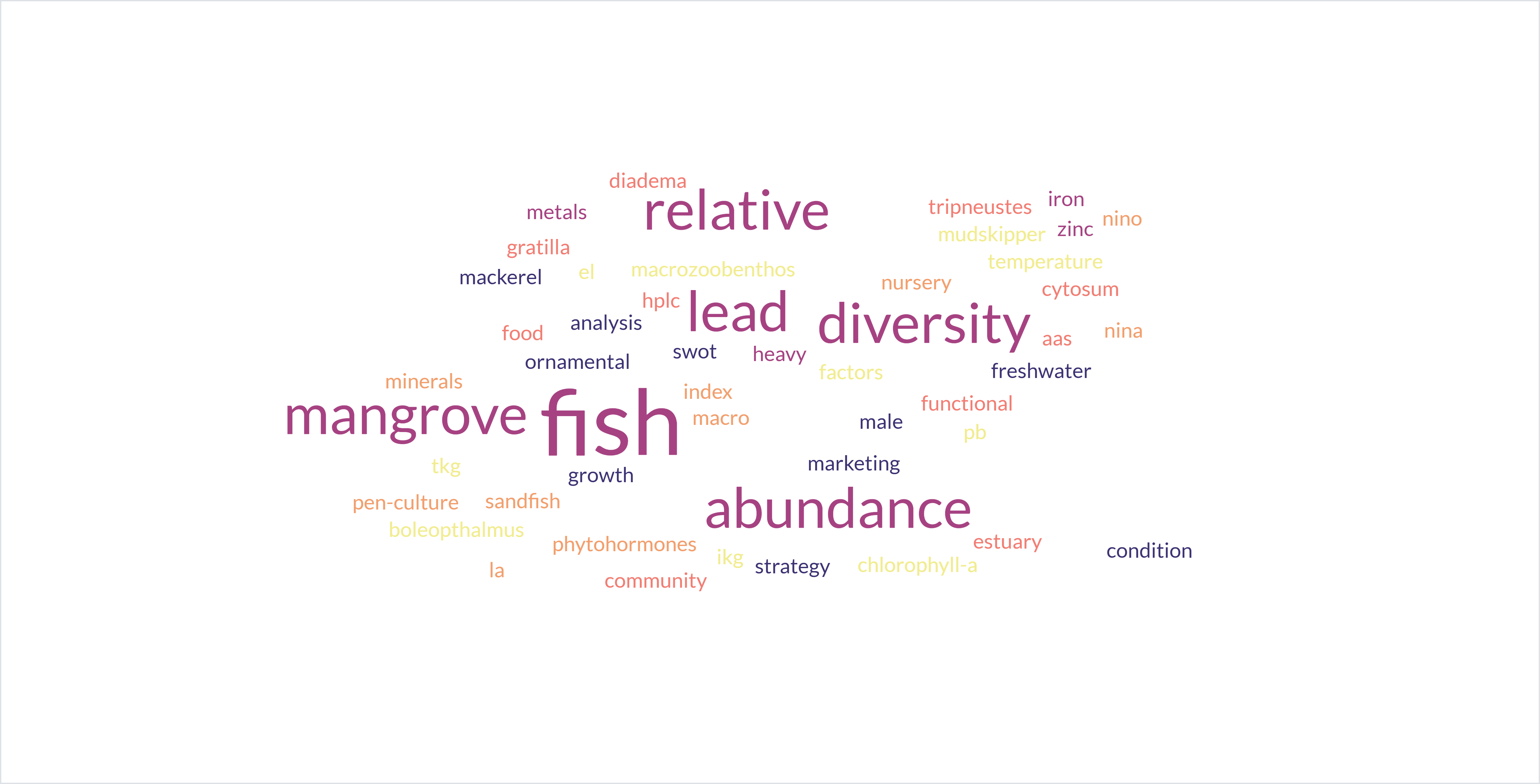Processing Banana Peel Organic Waste in Tourism Areas as an Effort to Control Aquatic Environmental Pollution
DOI:
https://doi.org/10.35800/jip.v12i1.55446Keywords:
Banana peel, Eco enzyme, Organic waste, Tourism, Waste generationAbstract
This study aims to analyze the weight of waste, recycling potential, and processing of banana peel organic waste into eco enzyme as an effort to control environmental pollution. The research was conducted in August-November 2023 in the Pasar Minggu Beach tourist area, Ambon City. The data collection method used direct observation in the field. Banana peel waste data was collected for 4 days, then weighed for further processing into eco enzyme for 3 months. Waste generation data and recycling potential were calculated using the formula set by the National Standardization Agency. The results showed that the weight of banana peel waste generated was 32.2 kg with 195 visitors. The average waste generation obtained was 0.17 or 0.2 kg/person/day, meaning that every visitor who comes to the tourist attractions produces 0.2 kg of banana peel waste. Banana waste that can be recycled is 30 kg and produces 112.5 l of ready-to-use eco enzyme solution. Processing banana peel organic waste into eco enzyme solution contributes ecologically and economically positively.
Keywords: Banana peel; Eco enzyme; Organic waste; Tourism; Waste generation.
Abstrak
Penelitian ini bertujuan untuk menganalisis berat timbulan, potensi daur ulang, serta pengolahan sampah organik kulit pisang menjadi eco enzyme sebagai upaya pengendalian pencemaran lingkungan. Penelitian dilakukan pada Agustus–November 2023 di kawasan wisata Pantai Pasar Minggu, Kota Ambon. Metode pengambilan data menggunakan metode observasi langsung di lapangan. Pengambilan data sampah kulit pisang dilakukan selama 4 hari, kemudian ditimbang beratnya untuk selanjutnya diolah menjadi eco enzyme selama 3 bulan. Data timbulan sampah dan potensi daur ulang dihitung merujuk pada rumus yang ditetapkan oleh Badan Standarisasi Nasional. Hasil penelitian menunjukan berat sampah kulit pisang yang dihasilkan sebesar 32,2 kg dengan jumlah pengunjung sebanyak 195 orang. Rata-rata timbulan sampah yang diperoleh sebesar 0,17 atau 0,2 kg/org/hr, artinya setiap pengunjung yang datang ke tempat wisata menghasilkan sampah kulit pisang sebesar 0,2 kg. Sampah pisang yang dapat didaur ulang sebesar 30 kg dan menghasilkan larutan eco enzyme siap pakai sebanyak 112,5 l. Pengolahan sampah organik kulit pisang menjadi larutan eco enzyme berkontribusi positif baik secara ekologis maupun ekonomis.
Kata Kunci: Kulit pisang; Eco enzyme; Sampah organik; Wisata, Timbulan sampah
References
Badan Pusat Statistik. (2023). Kota Ambon Dalam Angka 2023. BPS Kota Ambon.
Badan Standarisasi Nasional. (1994). Metode pengambilan dan pengukuran contoh timbulan dan komposisi sampah perkotaan. Badan Standardisasi Nasional, 16.
Borisova, D., Kostadinova, G., Petkov, G., Dospatliev, L., Ivanova, M., Dermendzhieva, D., & Beev, G. (2023). Assessment of CH4 and CO2 Emissions from a Gas Collection System of a Regional Non-Hazardous Waste Landfill, Harmanli, Bulgaria, Using the Interrupted Time Series ARMA Model. Atmosphere, 14(7). https://doi.org/10.3390/atmos14071089
Dukic, V. (2016). European Journal of Sustainable Development Research Proposals for the Protection of Water Resources. EJSDR, 1(1), 10–15.
Hatalea, A. (2022). Hari ke-10, Sampah di Pasar Minggu – Teluk Ambon Baguala Belum Juga Diangkut Petugas Kebersihan. Https://Ambon.Tribunnews.Com. https://ambon.tribunnews.com/2022/05/26/hari-ke-10-sampah-di-pasar-minggu-teluk-ambon-baguala-belum-juga-diangkut-petugas-kebersihan
Indraloka, A. B., Istanti, A., & Utami, S. W. (2023). The Physical and Chemical Characteristics of Eco-enzyme Fermentation Liquids from Several Compositions of Local Fruits and Vegetables in Banyuwangi. IOP Conference Series: Earth and Environmental Science, 1168(1). https://doi.org/10.1088/1755-1315/1168/1/012018
Ivanova, D. G., Ivanova, O. E., & Sukhinin, S. A. (2019). Ecological and Economic Aspects of the Waste Management Reform: The Experience of the Rostov Region. IOP Conference Series: Materials Science and Engineering, 698(7). https://doi.org/10.1088/1757-899X/698/7/077049
Kaihatu, M. M., & Hiariey., L. S. (2023). Sopapei Beach Tourism Development Strategy in Suli Village, Central Maluku District. IJOMRAL, 2(1), 136–146. https://doi.org/doi.org/10.53067/ijomral.v2i1
Lee, Y., Cho, J., Sohn, J., & Kim, C. (2023). Health Effects of Microplastic Exposures: Current Issues and Perspectives in South Korea. Yonsei Medical Journal, 64(5), 301–308. https://doi.org/10.3349/ymj.2023.0048
Mandasari, M., Indrawati, E., & Aqmal, A. (2023). Pemanfaatan Eco-Enzyme Dalam Stabilisasi Ph Air Media Budidaya Ikan Nila Oreochromis Niloticus Dengan Sistem Tanpa Pergantian Air. Journal of Aquaculture and Environment, 5(2), 54–59. https://doi.org/10.35965/jae.v5i2.2309
Muharomah, S. H. M., Hakim, L., & Febriatin, K. (2022). Persepsi Masyarakat Dalam Kepedulian Pengelolaan Sampah di Kelurahan Wancimekar Kecamatan Kotabaru. Nusantara: Jurnal Ilmu Pengetahuan Sosial, 9(6), 2228–2236.
Muliarta, I. N., & Darmawan, I. K. (2021). Processing Household Organic Waste into Eco-Enzyme as an Effort to Realize Zero Waste. Agriwar Journal, 1(1), 6–11.
Nugraha, A., Sutjahjo, S. H., & Amin, A. A. (2018). Analisis Persepsi Dan Partisipasi Masyarakat Terhadap Pengelolaan Sampah Rumah Tangga Di Jakarta Selatan. Jurnal Pengelolaan Sumberdaya Alam Dan Lingkungan (Journal of Natural Resources and Environmental Management), 8(1), 7–14. https://doi.org/10.29244/jpsl.8.1.7-14
Nugroho, S. P., & Hardani, I. P. (2020). Gastronomi Makanan Khas Keraton Yogyakarta Sebagai Upaya Pengembangan Wisata Kuliner. Jurnal Pariwisata, 7(1), 52–62. http://ejournal.bsi.ac.id/ejurnal/index.php/jp52
Nurhayati, A., & Burhanto, G. (2023). The Openness of Access and Behavior of Disposing of Garbage on the Riverbanks. Journal Sampurasun : Interdisciplinary Studies for Cultural Heritage, 9(1), 21–32. https://doi.org/10.23969/sampurasun.v9i1.7054
Patel, B. S., Solanki, B. R., & Mankad, A. U. (2021). Effect of eco-enzymes prepared from selected organic waste on domestic waste water treatment. World Journal of Advanced Research and Reviews, 10(1), 323–333. https://doi.org/10.30574/wjarr.2021.10.1.0159
Permatananda, P. A. N. K., Pandit, I. G. S., Cahyawati, P. N., & Aryastuti, A. A. S. A. (2023). Antimicrobial Properties of Eco Enzyme: A Literature Review. Bioscientia Medicina : Journal of Biomedicine and Translational Research, 7(6), 3370–3376. https://doi.org/10.37275/bsm.v7i6.831
Puger, I. G. N. (2018). Sampah Organik, Kompos, Pemanasan Global, Dan Penanaman Aglaonema Di Pekarangan. Agro Bali: Agricultural Journal, 1(2), 127–136. https://doi.org/10.37637/ab.v1i2.314
Puteri, A. D., & Yuristin, D. (2020). Pengaruh Pengetahuan Dan Perilaku Warga Dalam Menyikapi Sampah Rumah Tangga Terhadap Akumulasi Sampah Rumah Tangga di Kecamatan Bangkinang Seberang. Jurnal Kesehatan Tambusai, 1(1), 51–64.
Rapati, R. C., Victor, A., Raharjo, A. R., & Nuraisyah, A. (2023). Plastic Waste Management to Support The Circular Economy in The Pulp and Paper Industry. Business Review and Case Studies, 4(1), 1–11. https://doi.org/10.17358/brcs.4.1.1
Rusdianasari, Syakdani, A., Zaman, M., Sari, F. F., Nasyta, N. P., & Amalia, R. (2021). Production of Disinfectant by Utilizing Eco-enzyme from Fruit Peels Waste. International Journal of Research in Vocational Studies (IJRVOCAS), 1(3), 01–07. https://doi.org/10.53893/ijrvocas.v1i3.53
Solekah, N. A., Handriana, T., & Usman, I. (2022). Millennials’ Deals with Plastic: The Effect of Natural Environmental Orientation, Environmental Knowledge, and Environmental Concern on Willingness to Reduce Plastic Waste. Journal of Consumer Sciences, 7(2), 115–133. https://doi.org/10.29244/jcs.7.2.115-133
Suriani, M., Winarti, S., Arifin, S., Alpian, & Firlianty. (2023). Diversity of Decomposer Bacteria in Eco Enzyme Fermentation Process of Organic Materials Using Oxford Nanopore Technology (ONT) and Its Effectiveness In Inhibiting E. Coli in Fish Pond With Water Mineral Soil. RGSA – Revista de Gestão Social e Ambiental ISSN:, 17(8), 1–20. https://doi.org/doi.org/10.24857/rgsa.v17n8-009
Tuahatu, J. W., Tuhumury, N. C., & Manuputty, G. D. (2023). Analisis Komposisi , Timbulan dan Potensi Daur Ulang Sampah Pada Kawasan Wisata Pantai Natsepa, Kabupaten Maluku Tengah. Jurnal Sumberdaya Akuatik Indopasifik, 7(1), 75–84. https://doi.org/https://doi.org/10.46252/jsai-fpik-unipa.2023.Vol.7.No.1.249
Tuhumury, N. C., & Sahetapy, J. M. F. (2022). Analisis Bentuk dan Kelimpahan Mikroplastik Pada Ikan Budidaya dan Air di Perairan Teluk Ambon. Jurnal Grouper, 13(1), 18–25. https://doi.org/https://doi.org/10.30736/grouper.v13i1.106
Tuhumury, N. C., Sangadji, D. M. D., & Ummah, A. N. A. (2023). Analisis Timbulan Sampah dan Pemanfaatan Sampah Organik Berbasis Eco enzyme Pada Kawasan Wisata Kuliner Air Salobar, Kota Ambon. Jurnal Pengendalian Pencemaran Lingkungan (JPPL), 5(2), 142–149. https://doi.org/10.35970/jppl.v5i2.2021
Vidalia, C., Angelina, E., Hans, J., Field, L. H., Santo, N. C., & Rukmini, E. (2023). Eco-enzyme as Disinfectant: A Systematic Literature Review. International Journal of Public Health Science, 12(3), 1171–1180. https://doi.org/10.11591/ijphs.v12i3.22131
Viza, R. Y. (2022). Uji Organoleptik Eco-Enzyme dari Limbah Kulit Buah. BIOEDUSAINS:Jurnal Pendidikan Biologi Dan Sains, 5(1), 24–30. https://doi.org/10.31539/bioedusains.v5i1.3387
Wikaningrum, T., & Anggraina, P. L. (2022). The eco enzyme application to reduce nitrite in wastewater is the sustainability alternative solution to garbage and wastewater problems. IOP Conference Series: Earth and Environmental Science, 1065(1). https://doi.org/10.1088/1755-1315/1065/1/012023
Yang, M., Chen, L., Wang, J., Msigwa, G., Osman, A. I., Fawzy, S., Rooney, D. W., & Yap, P. S. (2023). Circular Economy Strategies for Combating Climate Change and Other Environmental Issues. Environmental Chemistry Letters, 21(1), 55–80. https://doi.org/10.1007/s10311-022-01499-6
Yustiani, Y. M., Nugroho, F. L., Murtadho, F. Z., & Djayadisastra, A. T. (2023). Use of Eco Enzyme to Reduce the Chemical Oxygen Demand of Synthetic River Water. Journal of Engineering and Technological Sciences, 55(1), 91–97. https://doi.org/10.5614/j.eng.technol.sci.2023.55.1.9.
Downloads
Published
How to Cite
License
Copyright (c) 2024 Novianty Tuhumury, Jacqueline M F Sahetapy, Jolen Matakupan, Stefanno M A Rijoly

This work is licensed under a Creative Commons Attribution-NonCommercial 4.0 International License.
COPYRIGHT
Authors who publish with this journal agree to the following terms:
Authors hold their copyright and grant this journal the privilege of first publication, with the work simultaneously licensed under a Creative Commons Attribution License that permits others to impart the work with an acknowledgment of the work's origin and initial publication by this journal.
Authors can enter into separate or additional contractual arrangements for the non-exclusive distribution of the journal's published version of the work (for example, post it to an institutional repository or publish it in a book), with an acknowledgment of its underlying publication in this journal.
Authors are permitted and encouraged to post their work online (for example, in institutional repositories or on their website) as it can lead to productive exchanges, as well as earlier and greater citation of the published work (See The Effect of Open Access).






































